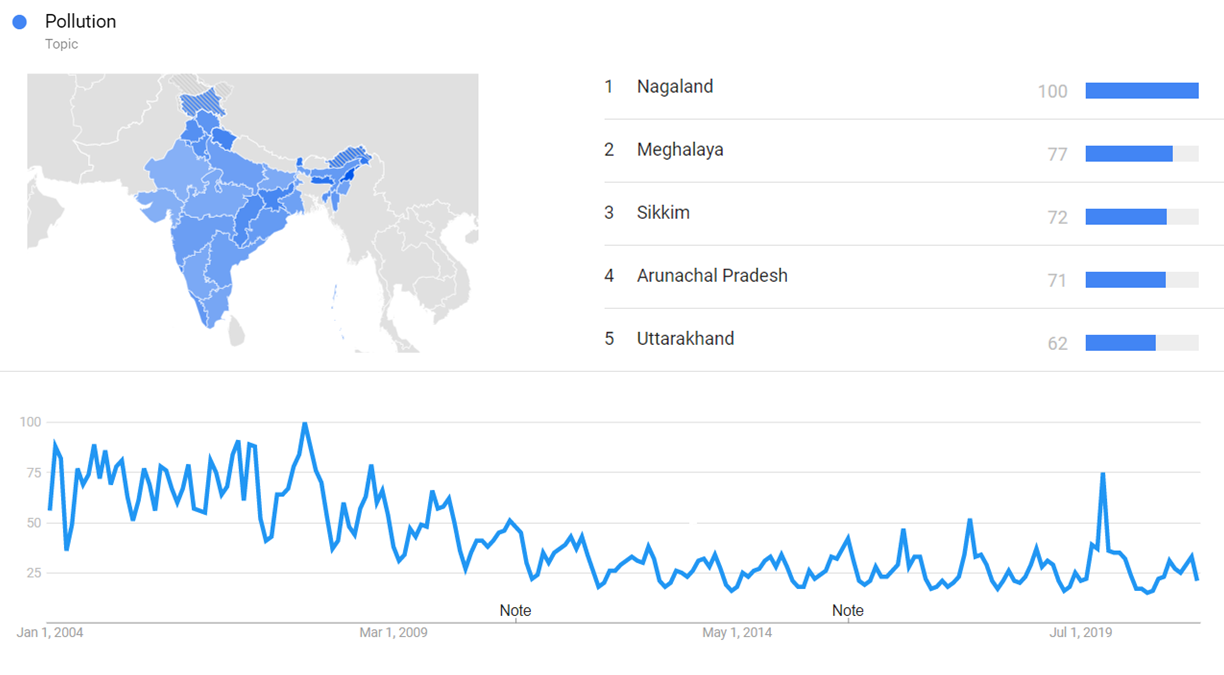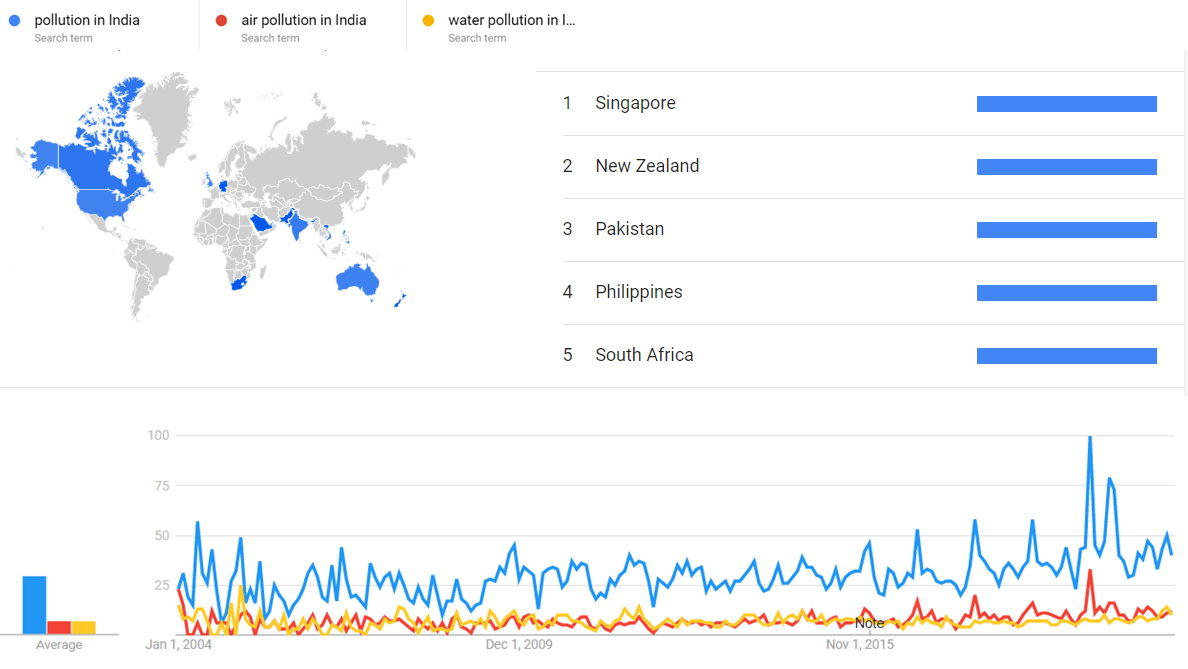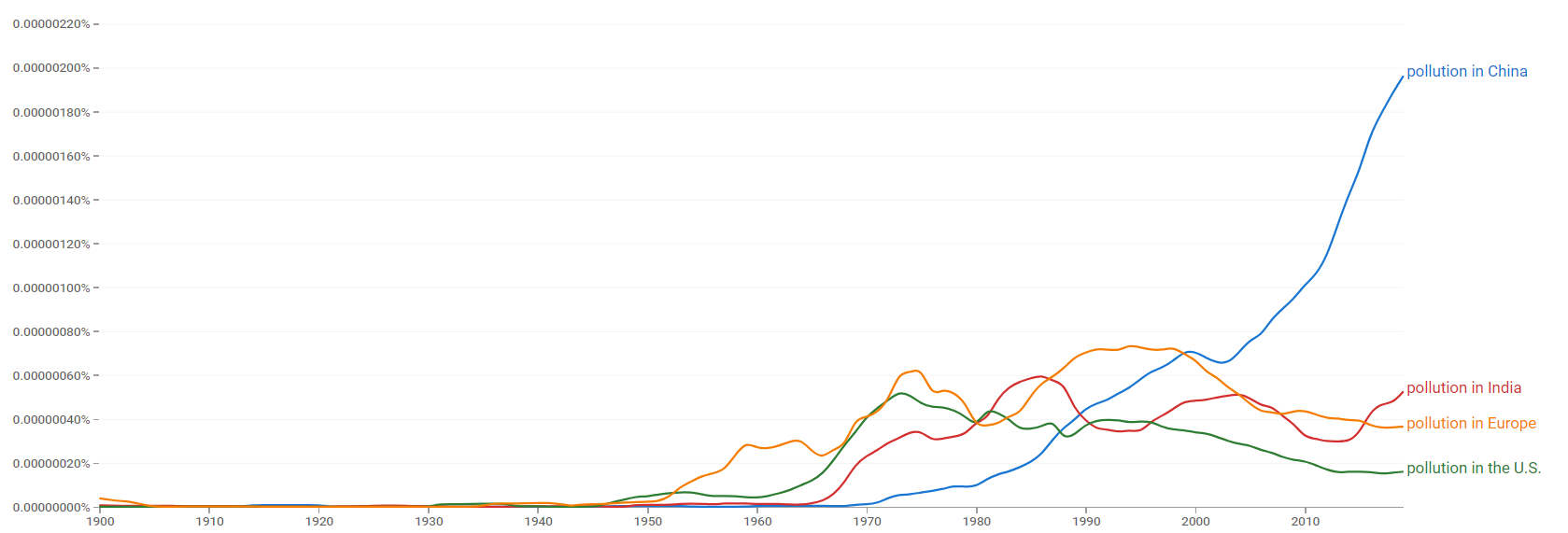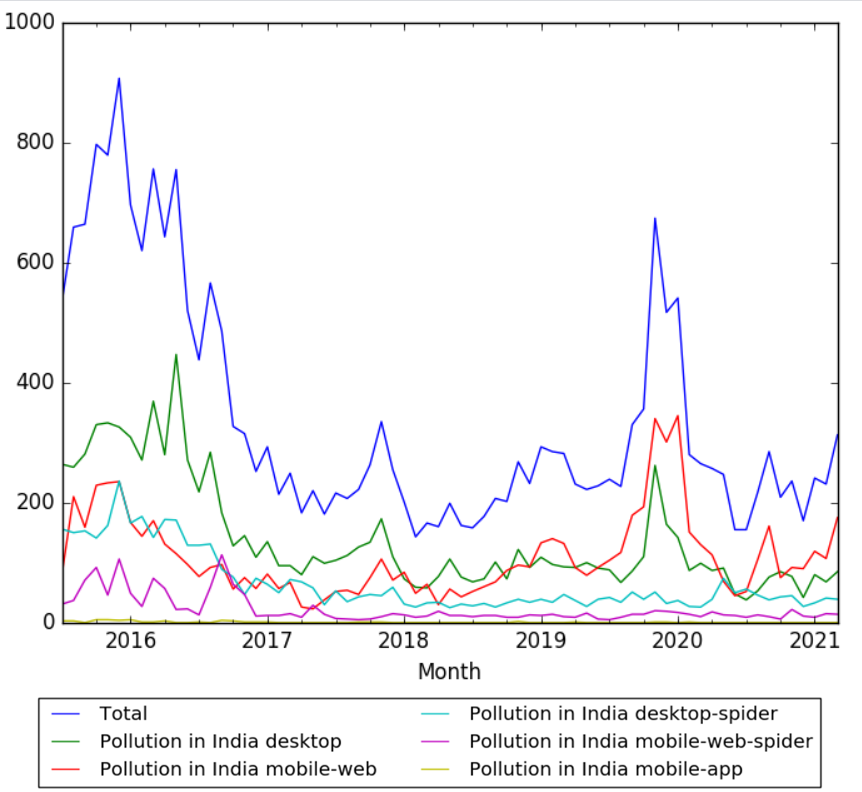Timeline of pollution in India
This is a timeline of pollution in India, attempting to describe progression in coping with all kinds of pollution in the country. Incumbent environmental policies are included.
Big picture
| Time period | Development summary |
|---|---|
| 1970s | Early government initiatives towards environmental protection begin. Policy responses for the prevention and control of environmental degradation start being implemented in India.[1] |
| 1980s | As in the 1970s, a great number of environmental laws are passed. Government initiatives increasingly focus on the pollution of the Ganges.[2] In 1984 the Bhopal disaster occurs. |
| 1990s | Reforms on environmental laws are introduced. Since then, for the first time in Indian history, major air pollutant concentrations would drop in every 5 year period.[3] Sulfur dioxide levels in Indian cities start declining due to a fuel shift from biomass-based fuels to liquefied petroleum gas, and from coal to kerosene.[4] |
| 2000s | More regulations are introduced during the decade. However, pollution continues to be a serious issue. Sulfur dioxide emissions increase, and water pollution remains concerning. The Delhi’s pollution control program becomes the basis for other cities to adopt similar efforts as heavily polluted Indian cities are identified in the mid-decade.[5] |
| 2010s | The largest number of people killed by air pollution worldwide per year are found in India. Towards the end of the decade, India falls in the rank of Environmental Performance Index, ending among the bottom five countries. |
Full timeline
| Year | Month and date | Category | Event type | Details |
|---|---|---|---|---|
| 1853 | Water pollution | Policy | The Shore Nuisance (Bombay and Kolaba) Act is introduced. It is one of the earliest laws to adress water pollution and is able to authorize the Collector of Land Revenue in Bombay to order the removal of any nuisance in Bombay harbour.[3] | |
| 1857 | Air pollution | Policy | The Oriental Gas Company Act is introduced.[3] | |
| 1860 | Water pollution | Policy | The Indian Penal Code imposes a fine on anyone who voluntarily fouls the water of any public spring or reservoir.[3] | |
| 1860s | Wastewater management | Infrastructure | Bombay and Calcutta become the first cities to build sewerage systems, aimed at serving primarily to the needs of European quarters.[2] | |
| 1870s | Wastewater management | Infrastructure | The Government of India and the state governments transfer the financial responsibility for urban sanitary infrastructures to the municipalties.[2] | |
| 1905 | Air pollution | Policy | The Bengal Smoke Nuisance Act is introduced.[3][6] | |
| 1912 | Air pollution | Policy | The Bombay Smoke Nuisance Act is introduced.[3] | |
| 1974 | Water pollution | Policy | The Water (Prevention and Control of Pollution) Act is introduced.[3][2] | |
| 1974 | September 22 | General | Organization | The Central Pollution Control Board is formed. It runs nationwide programs of ambient air quality monitoring [7][8][9][10] |
| 1975 – 1995 | Air pollution | Statistics | According to The Centre for Science and Environment, in this period during which the country's economy (gross domestic product or gdp) grew by about 2.5 times the vehicular pollution load grew by eight times.[11] | |
| 1980 | General | Policy | The Forest (Conservation) Act is introduced.[3][2] | |
| 1980 | General | Organization | The Centre for Science and Environment, one of India’s first environmental NGOs to analyze and study the relationship between environment and development and create public consciousness about the need for sustainable development.[12] | |
| 1981 | March | Air pollution | Policy | The Air (Prevention and Control of Pollution) Act is passed to regulate air pollution.[13][14][3][2] |
| 1982 | General | Policy | India establishes the Pollution Control Board, aimed at monitoring and curbing air, land and water pollution brought on by the booming textile industry in the country.[15] | |
| 1985 | General | Organization | The Ministry of Environment and Forests is created by the Indian Government. This ministry is the central administrative organisation in India for regulating and ensuring environmental protection.[3] | |
| 1984 | December | Air pollution | Crisis | The Bhopal Disaster happens as the world's worst short-term civilian pollution crisis.[16]. An accident at the Union Carbide pesticide plant in Bhopal releases at least 30 tons of methyl isocyanate, a highly toxic gas. More than 600,000 people are exposed, and between 3,800 and 16,000 people are killed. Government figures later refer to an estimate of 15,000 killed over the years.[17][18][19] |
| 1985 | Water pollution | Program | The Indian Government devises the "Ganga Action Plan", an ambitious and heavily funded plan to clean the Ganges river.[2] | |
| 1986 | November | General | Policy | Triggered by the Bhopal Disaster, the Government of India enacts the Environment Protection Act. The purpose of the Act is to implement the decisions of the United Nations Conference on the Human Environment.[20][3][2][10] |
| 1992–2010 | Research | Satellite data analized during the period confirms India's forest coverage has increased for the first time by over 4 million hectares, a 7% increase.[3] | ||
| 1995 | Water pollution | Research | Report claims that 114 Indian cities dump untreated sewage and partially cremated bodies directly into the Ganges River.[21] | |
| 1995–2010 | General | Recognition | During this period, India is recognized as having made some of the fastest progress in addressing its environmental issues and improving its environmental quality in the world.[22][23] | |
| 1996–2010 | Air pollution | Study | According to study, oxides of nitrogen emissions from Indian thermal power plants increased at least 70% over this period.[4] | |
| 1996 | Water pollution | Policy | The Pollution Control Board issues orders to the textile units to remove colour from the effluents before discharging it into the rivers.[15] | |
| 1999 | Noise pollution | Policy | A draft of Noise Pollution (Control and Regulation) Rules is published under the notification of the Government of India in the Ministry of Environment and Forests.[24] | |
| 1999 | General | Policy | The Supreme Court of India adopts Delhi’s pollution control program, designed by the Environment Pollution (Prevention and Control) Authority. The Delhi program becomes the basis for other cities to adopt similar efforts.[5] | |
| 1999 | Air pollution | Policy | The Indian Government introduces the first-ever fuel specifications based on environmental considerations, the push for higher emission standards.[25] | |
| 2000 | Noise pollution | Policy | The Government of India enacts a set of Noise Pollution (Regulation & Control) Rules.[3] | |
| 2001 | General | Policy | The Energy Conservation Act establishes the Bureau of Energy Efficiency, which is tasked with reducing the energy intensity of the economy.[26] | |
| 2004 | Water pollution | Policy | The Pollution Control Board begins to ask factories to implement zero liquid discharge.[15] | |
| 2005–2014 | Air pollution | Research | Data from Nasa’s Aura satellite shows that total sulfur dioxide emissions over India have nearly doubled in the period.[4] | |
| 2006–2008 | Water polution | Research | In 2006, 47 percent of water quality monitoring reports coliform concentration above 500 MPN/100 ml. By 2008, 33 percent of all water quality monitoring stations would report a total coliform level exceeding those levels, suggesting efforts to add pollution control infrastructure and upgrade treatment plants in India, which may be reversing the water pollution trend.[27] | |
| 2007 | November | Air pollution | Research | A 25-year-long study on 27,000 children finds that 50% Bangalore kids are hit by asthma.[28] |
| 2007 | Water pollution | Research | A study finds that discharge of untreated sewage is the single most important cause of pollution of surface and groundwater in the country.[1] | |
| 2008 | Water pollution | Research | A joint study by PGIMER and Punjab Pollution Control Board ireveals that in villages along the Nullah, fluoride, mercury, beta-endosulphan and heptachlor pesticide are more than permissible limit (MPL) in ground and tap water. Plus the water has high concentration of chemical and biochemical oxygen demand, ammonia, phosphate, chloride, chromium, arsenic and chlorpyrifos pesticide. The ground water also contains nickel and selenium, while the tap water has high concentration of lead, nickel and cadmium.[29] | |
| 2008 | Water pollution | Research | Study reports wastewater generation in urban India to be 38,254 million liters per day, out of which 26,467 million liters per day was untreated.[1] | |
| 2009 | February 20 | Water pollution | Organization | The National Ganga River Basin Authority is established by the Central Government of India. It also declares Ganges as the "National River" of India.[30][31] |
| 2009 | Water pollution | Program | The Indian Government establishes the National Ganga River Basin Authority (NGRBA) and initiates the "Mission Clean Ganga". The program in supported by the World Bank with one billion dollars.[2] | |
| 2010 | Water pollution | Research | A water quality monitoring finds almost all rivers with high levels of biochemical oxygen demand (a measure of pollution with organic matter). The worst pollution, in decreasing order, were found in river Markanda (490mg/l BOD), followed by Kali river (364), river Amlakhadi (353), Yamuna canal (247), Yamuna river at Delhi (70) and Betwa river (58). For context, a water sample with a 5-day BOD between 1 and 2 O/L indicates a very clean water, 3 to 8 O/L indicates a moderately clean water, 8 to 20 indicates borderline water, and greater than 20mg O/L indicates ecologically-unsafe, polluted water. The levels of BOD are severe near the cities and major towns. However, in rural parts of India, the river BOD levels were sufficient to support aquatic life.[32][33] | |
| 2010 | Air pollution | Statistics | The Central Pollution Control Board (CPCB) finds that in the year, particulate matter in the air of 180 Indian cities was six times higher than World Health Organization standards.[34] | |
| 2010 | General | Organization | The Indian Government establishes dedicated green courts in the form of the National Green Tribunal (NGT) to rapidly resolve environmental cases.[25] | |
| 2011 | Air pollution | Policy | The Indian Government sets up its National Mission for Electric Mobility, which aims to promote electric vehicle (EV) and hybrid manufacturing.[26] | |
| 2012 | Air pollution | Research | An estimated 1.5 million people died from the effects of air pollution in the country in the year, according to data from the World Health Organization.[35] | |
| 2013 | September | Air pollution | Research | Study on non-smokers finds that Indians have 30% lower lung function compared to Europeans.[36] |
| 2015 | April | Air pollution | Index release | The Government of India, together with IIT Kanpur launch the National Air Quality Index, an alert system that notifies the public about air pollution levels and associated health risks. The project aims to increase public awareness.[37][34][38] |
| 2015 | Air pollution | Statistics | India overtakes the United States and becomes the world’s second largest coal consumer after China.[26] | |
| 2015 | December | Air pollution | Policy | India sets new emissions standards for air pollution from coal plants for compliance in 2017, with looser standards for older plants.[26][39] |
| 2015 | Air pollution | Policy | The FAME India (Faster Adoption and Manufacture of Hybrid and Electric Vehicles) Scheme is adopted to subsidize electric and hybrid cars, mopeds, rickshaws and buses.[40] | |
| 2015 | General | Statistics | Study reports that of 6.5 million people killed by air pollution worldwide during the year, the largest number, about 1.8 million, lived in India.[25] | |
| 2016 | General | Statistics | The Environmental Performance Index ranks India 141 out of 180 countries.[41] | |
| 2016 | General | Statistics | A study by the World Health Organization reports that fourteen of the twenty world’s most polluted cities are in India.[42] | |
| 2017 | Air pollution | Research | Study published in The Lancet estimates that in the year air pollution killed 1.24 million Indians — half of them younger than 70, which lowers the country’s average life expectancy by 1.7 years. The 10 most polluted cities in the world are all in northern India.[43] | |
| 2017 | Air pollution | Statistics | India ranks the third largest producer of territorial fossil fuel CO2 emissions worldwide.[44] | |
| 2018 | January | General | Statistics | India ranks 177 out of 180 in Environmental Performance Index, among the bottom five countries, and plummeting 36 places from 141 in 2016.[41] |
| 2019 | Air pollution | Program | India launches 'The National Clean Air Programme' with tentative national target of 20%-30% reduction in PM2.5 and PM10 concentrations by 2024, considering 2017 as the base year for comparison. It would be rolled out in 102 cities that are considered to have air quality worse than the National Ambient Air Quality Standards.[45] | |
| 2019 | March | General | Statistics | According to Greenpeace, 22 of world's 30 most polluted cities are in India.[46] |
| 2019 | June | Air pollution | Research | The Centre for Science and Environment, an environment think tank, reports that life expectancy in India has gone down by 2.6 years due to deadly diseases caused by air pollution. The report reveals that outdoor and household air pollution together are causing deadly diseases.[47] |
| 2019 | June | Air pollution | Research | Study reports on air pollution killing more than 100,000 children under five every year.[48] |
| 2020 | Air pollution | Program | India is expected to advance the date for stricter fuel and emission norms by this time, so new vehicles sold after it would be far cleaner.[43] | |
| 2030 | Air pollution | Policy | India pledges a 33-35% reduction in the “emissions intensity” of its economy by the time, compared to 2005 levels.[26] | |
| 2030 | Air pollution | Policy | All new urban buses are planned to be fully electric by the time.[26] |
Visual data
Google Trends
The chart below shows Google Trends data (India) for Pollution, from January 2004 to April 2021, when the screenshot was taken. Interest is also ranked by state and displayed on map.[49]

The comparative chart below shows Google Trends data for Pollution in India (Search term), air pollution in India (Search term) and water pollution in India (Search term), from January 2004 to April 2021, when the screenshot was taken. Interest is also ranked by country and displayed on world map.[50]

Google Ngram Viewer
The comparative chart below shows Google Ngram Viewer data for pollution in China, pollution in India, pollution in the US and pollution in Europe, from 1900 to 2019.[51]

Wikipedia Views
The chart below shows pageviews of the English Wikipedia article Pollution in India, from July 2015 to March 2021.[52]

Meta information on the timeline
How the timeline was built
The initial version of the timeline was written by User:Sebastian.
Funding information for this timeline is available.
Feedback and comments
Feedback for the timeline can be provided at the following places:
- FIXME
What the timeline is still missing
- [1] (for visual data)
Timeline update strategy
See also
External links
References
- ↑ 1.0 1.1 1.2 Chakraborty, Debesh; Mukhopadhyay, Kakali. Water Pollution and Abatement Policy in India: A Study from an Economic Perspective.
- ↑ 2.0 2.1 2.2 2.3 2.4 2.5 2.6 2.7 2.8 Wilhelm, Janine. Environment and Pollution in Colonial India: Sewerage Technologies along the Sacred Ganges.
- ↑ 3.00 3.01 3.02 3.03 3.04 3.05 3.06 3.07 3.08 3.09 3.10 3.11 3.12 "History of pollution in India". pollutedindia.weebly.com. Retrieved 15 May 2019.
- ↑ 4.0 4.1 4.2 Bhuyan, Ragini. "So, how polluted is India's air, really?". livemint.com. Retrieved 12 June 2019.
- ↑ 5.0 5.1 "Pathways for Developing a Natural Gas Vehicle Market". csis.org. Retrieved 14 June 2019.
- ↑ "Smoke laws first enacted in city of joy". downtoearth.org.in. Retrieved 10 June 2019.
- ↑ "Central Pollution Control Board". cpcb.nic.in. Retrieved 29 April 2019.
- ↑ "Central Pollution Control Board". iasupsc.com. Retrieved 11 June 2019.
- ↑ Jain, Sharad K.; Agarwal, Pushpendra K.; Singh, Vijay P. Hydrology and Water Resources of India.
- ↑ 10.0 10.1 Advanes in Water Quality & Management.
- ↑ "When will India be able to control pollution ?". downtoearth.org.in. Retrieved 24 May 2019.
- ↑ "Anil Agarwal". cseindia.org. Retrieved 18 May 2019.
- ↑ "The Air (Prevention and Control of Pollution) Act, 1981" (PDF). indiaenvironmentportal.org.in. Retrieved 23 May 2019.
- ↑ "Data : India – Environmental Performance Index – Development". Yale University. 2016. Retrieved 8 April 2016.
- ↑ 15.0 15.1 15.2 "Green innovation saves the textile industry in India". aljazeera.com. Retrieved 12 June 2019.
- ↑ "20th anniversary of world's worst industrial disaster". abc.net.au. Retrieved 6 May 2019.
- ↑ "Bhopal: The World's Worst Industrial Disaster, 30 Years Later". theatlantic.com. Retrieved 11 June 2019.
- ↑ "30 years of Bhopal gas tragedy: a continuing disaster". downtoearth.org.in. Retrieved 11 June 2019.
- ↑ Broughton, Edward. "The Bhopal disaster and its aftermath: a review". doi:10.1186/1476-069X-4-6. PMC 1142333. PMID 15882472.
{{cite journal}}: Cite journal requires|journal=(help)CS1 maint: unflagged free DOI (link) - ↑ Chakraborty, Vaibhav. "Environment Protection Act 1986- Protecting India's Environment". mapsofindia.com. Retrieved 11 June 2019.
- ↑ National Geographic Society. 1995. Water: A Story of Hope. Washington (DC): National Geographic Society
- ↑ The Little Green Data Book, The World Bank, 2010
- ↑ Environment Assessment, Country Data: India, The World Bank, 2011
- ↑ "Implementation of Noise Rules". cpcb.nic.in. Retrieved 10 June 2019.
- ↑ 25.0 25.1 25.2 Srivastava, Deepali. "In India, Can the World's Cleanest Fuel Clear the Air?". nextcity.org. Retrieved 12 June 2019.
- ↑ 26.0 26.1 26.2 26.3 26.4 26.5 "The Carbon Brief Profile: India". carbonbrief.org. Retrieved 10 June 2019.
- ↑ "Central Pollution Control Board, India, Annual Report 2008–2009" (PDF). Central Pollution Control Board, Ministry of Environment & Forests, Govt of India. 2009.
- ↑ "50% Bangalore kids hit by asthma". timesofindia.indiatimes.com. Retrieved 24 May 2019.
- ↑ "Buddha Nullah the toxic vein of Malwa". Indian Express. May 21, 2008.
- ↑ "National Ganga River Basin Authority"
- ↑ "Composition of NGRBA."
- ↑ "Evaluation Of Operation And Maintenance Of Sewage Treatment Plants In India-2007" (PDF). Central Pollution Control Board, Ministry of Environment & Forests. 2008.
- ↑ Kaur et al., Wastewater production, treatment and use in India UN Water (Publisher)
- ↑ 34.0 34.1 "India Announces National Air Quality Index to Increase Public Awareness". nrdc.org. Retrieved 10 June 2019.
- ↑ "Bulletin of the World Health Organization". who.int. Retrieved 24 May 2019.
- ↑ "Indians have 30% weaker lungs than Europeans". Times of India. Sep 2, 2013.
- ↑ "Choking India gets air quality index". economictimes.indiatimes.com. Retrieved 14 June 2019.
- ↑ "National Air Quality Index". iitk.ac.in. Retrieved 10 June 2019.
- ↑ "New thermal power plants will have to comply with emission standards". timesofindia.indiatimes.com. Retrieved 10 June 2019.
- ↑ "What is FAME India Scheme?". indianeconomy.net. Retrieved 15 June 2019.
- ↑ 41.0 41.1 "India ranks 177 out of 180 in Environmental Performance Index". economictimes.indiatimes.com. Retrieved 10 June 2019.
- ↑ "Indian cities and air pollution". orfonline.org. Retrieved 12 June 2019.
- ↑ 43.0 43.1 "Dirty air: how India became the most polluted country on earth". ig.ft.com. Retrieved 15 May 2019.
- ↑ "Largest producers of territorial fossil fuel CO2 emissions worldwide in 2017, based on their share of global CO2 emissions". statista.com. Retrieved 24 May 2019.
- ↑ "National Clean Air Programme". 2019. Retrieved 18 January 2019.
- ↑ Van Mead, Nick. "22 of world's 30 most polluted cities are in India, Greenpeace says". theguardian.com. Retrieved 12 June 2019.
- ↑ "Life expectancy in India down by 2.6 yrs due to air pollution". economictimes.indiatimes.com. Retrieved 12 June 2019.
- ↑ "Air pollution kills 100,000 Indian children every year, study says". cbsnews.com. Retrieved 12 June 2019.
- ↑ "Pollution (India)". Google Trends. Retrieved 21 April 2021.
- ↑ "Pollution in India, air pollution in India and water pollution in India". Google Trends. Retrieved 12 April 2021.
- ↑ "pollution in China, pollution in India, pollution in the US and pollution in Europe". books.google.com. Retrieved 20 April 2021.
- ↑ "Pollution in India". wikipediaviews.org. Retrieved 12 April 2021.